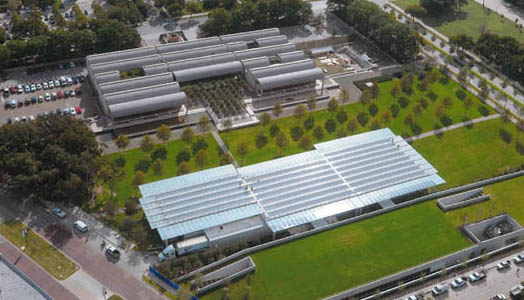Info & Images: Courtesy RPBW
 |
| . |
Originally designed by Louis Kahn in 1972, Kimbell Art Museum’s new building that
accommodates its growing exhibition and education programmes is designed by Ar.
Renzo Piano.
The programmes and collection of Fort Worth’s Kimbell Art Museum have
grown dramatically in recent years, far beyond anything envisioned by the
museum in the 1970s.
.gif) |
| . |
Addressing the severe lack of space for the
museum’s exhibition and education programmes, the new building designed by Renzo
Piano Building Workshop architects in collaboration with Kendall/Heaton
Associates, Inc. (Houston) roughly
doubles the museum’s gallery space and provides classrooms and studios for the
museum’s education department, a large auditorium of 299 seats, an expanded
library and underground parking. It also proposes to be highly energy
efficient, requiring only one fourth of the energy consumed by the Kahn building.
.jpg) |
| . |
Subtly echoing Kahn’s building in height, scale
and general layout, the RPBW building has a more open, transparent character.
Light, discreet (half the footprint hidden underground), yet with its own
character, setting up a dialogue between old and new. The new building consists
of two connected structures.
.jpg) |
| . |
The front section, facing the west façade of
Kahn’s building across landscaped grounds, has a three-part façade, referencing
the activities inside. At its centre a lightweight, transparent, glazed section
serves as the new museum entrance. On either side, behind pale concrete walls
are two gallery spaces for temporary exhibitions.
.jpg) |
| . |
A colonnade of square concrete columns wraps
around the sides of the building, supporting solid wooden beams and the
overhanging eaves of the glass roof, providing shade for the glazed facades
facing north and south.
.jpg) |
| . |
.jpg) |
| . |
In the galleries, a sophisticated roof system
layers stretched fabric, the wooden beams, glass, aluminium louvers (and
photovoltaic cells), to create a controlled day-lit environment. This can be
supplemented by lighting hidden behind the scrim fabric.
.jpg) |
| . |
A glazed passageway leads into the building’s
second structure. Hidden under a turf, insulating roof are a third gallery for
light-sensitive works, an auditorium and museum education facilities.
.jpg) |
| . |
Glass, concrete, and wood are the predominant
materials used in the new building, echoing those used in the original. Views
through the new building to the landscape and Kahn building beyond emphasise
the key motifs of transparency and openness.

No comments :
Post a Comment